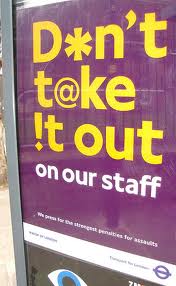Many of us denounce bad service and announce we will not frequent businesses that have such service. Yet we sometimes do.
Why?
Many of us denounce bad service and announce we will not frequent businesses that have such service. Yet we sometimes do.
Why?
 When I was in London in April, I was surprised to see these signs scattered around transit areas.
When I was in London in April, I was surprised to see these signs scattered around transit areas.
It made me wonder if there had been so many incidents of passengers abusing the staff that they needed to post signs telling them to stop.
It also made me wonder if the signs had any affect. Generally, signs don’t change negative behavior. With few exceptions, “No Littering” signs don’t stop people from littering.
I can’t imagine someone being angry enough to curse at a bus driver, but then think, “I better not. The sign said to not take it out on the staff.” I don’t think that’s how people think.
I’ve rarely had it, but know I have once in a while.
You may have, too.
It’s an affliction that has affected millions.
It creeps upon you without your becoming aware of it. You display classic signs, yet they seem normal. After all, so many people in your circle display the same symptoms.
What is this dreaded malady?
I travel a lot. Both domestically and internationally. Whenever I fly a new carrier, I check their luggage restrictions and do my very best to ensure I don’t have additional charges.
So imagine my dismay when a companion and I flew EasyJet the other day. We had carefully calculated how many bags and weight we’d have to pre-purchase and dutifully went to their web page to purchase the extras on the day of the flight.

The luxurous Huis ter Duin hotel in Noordwijk, on the Netherlands’ North Sea, is known for it’s location and its comforts. As you would guess, it also has great service.
I have had the good fortune to stay in other fine hotels around the world serving clients. I appreciate good service. But at this conference of 200 attendees, this hotel did a few things that made it stand out above many others.
For example:
 Often companies ignore the importance of empowering staff without “customer service” in their title. They think that the employees who aren’t formally charged with customer interaction don’t need to be customer focused. They usually don’t invest much (any?) time or money to train these people. And they nearly never give them any tools to help ease any customer annoyance.
Often companies ignore the importance of empowering staff without “customer service” in their title. They think that the employees who aren’t formally charged with customer interaction don’t need to be customer focused. They usually don’t invest much (any?) time or money to train these people. And they nearly never give them any tools to help ease any customer annoyance.
Imagine my surprise, then, at the customer focus of a Redbox video vending employee named Susan.
“No surprise!” you say. “The government doesn’t have a clue how to treat its customers — us!”
The USPS spent millions a decade ago on customer service training. Generally, the clerks I’ve encountered are pleasant and some go out of their way to be friendly to their customers.
Other agencies not so much.
I witnessed a painful (to me) conversation between two male colleagues I admire. I’d been asked by Colleague A to attend a meeting between the 3 of us as we all serve on a committee together. I asked him the purpose of the meeting and he told me what he wanted to discuss.
During the exchange, I winced as Colleague A called Colleague B on the carpet for a promise B made to A about our project. He recounted a conversation they’d had 18 months ago, to which B said he had a different memory. It had little to do with the stated purpose of our discussion, so I tried to bring them back to focus.
I’ve observed both these men finesse difficult conversations adroitly. Yet this time they both succumbed to expressing their dissatisfaction with each other. I was as frustrated as they were with the interaction.
Afterwards, I thought of some ways anyone could finesse a contentious conversation:
Read the AmEx OpenForum article interviewing me on “4 Steps for Handling a Surge in Customer Complaints.”
 Jerry Lewis is known for his rubbery face, silly body language and odd voices.
Jerry Lewis is known for his rubbery face, silly body language and odd voices.
Why would a well-respected business presenter want to do anything like Jerry Lewis? After all, you have important ideas and information to impart. To be anything but serious would cast doubt on your data, let alone your mental state.
Several years ago, after 28 years as a professional presenter, I learned the value of channeling my inner Jerry Lewis in my business presentations around the world.